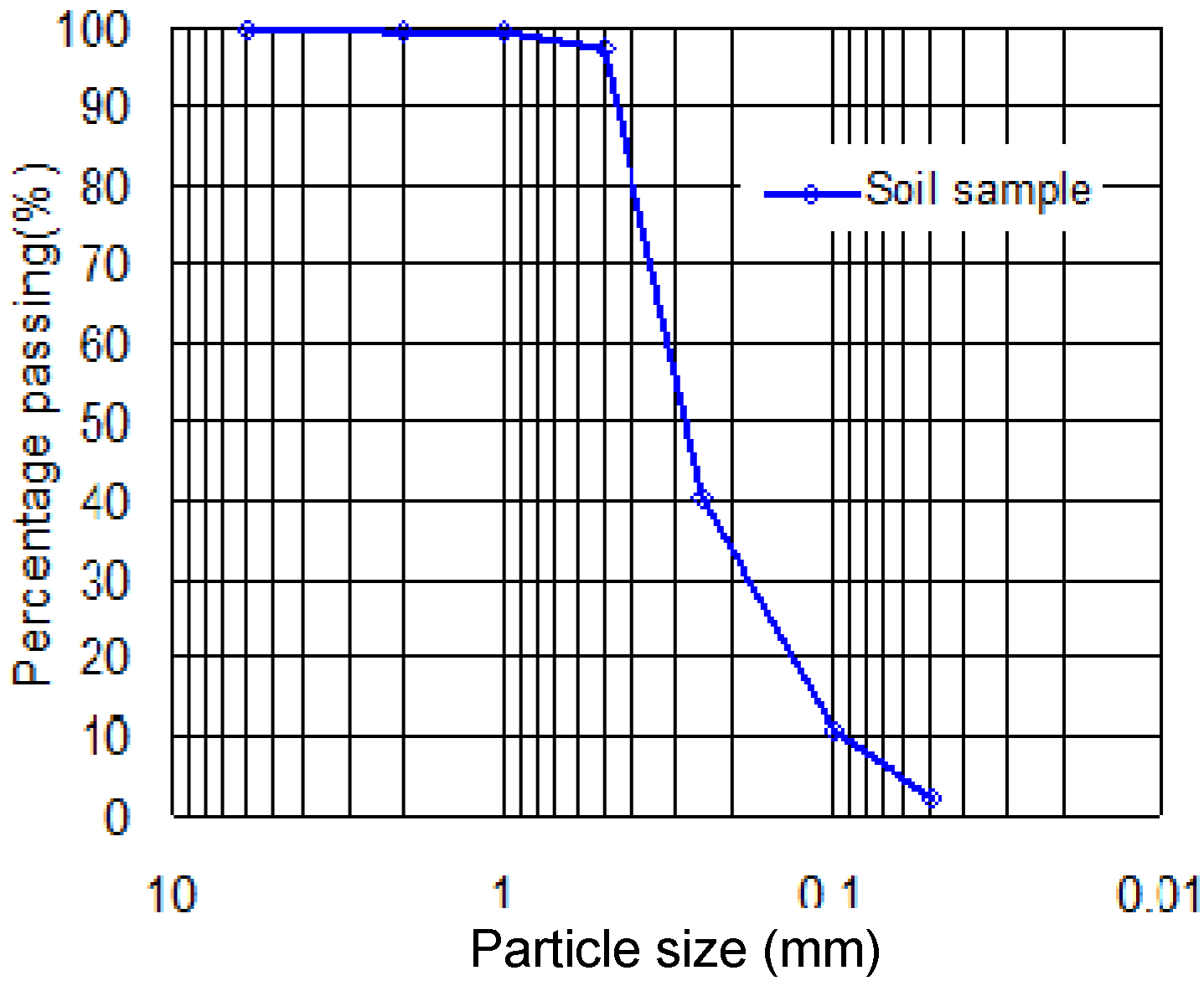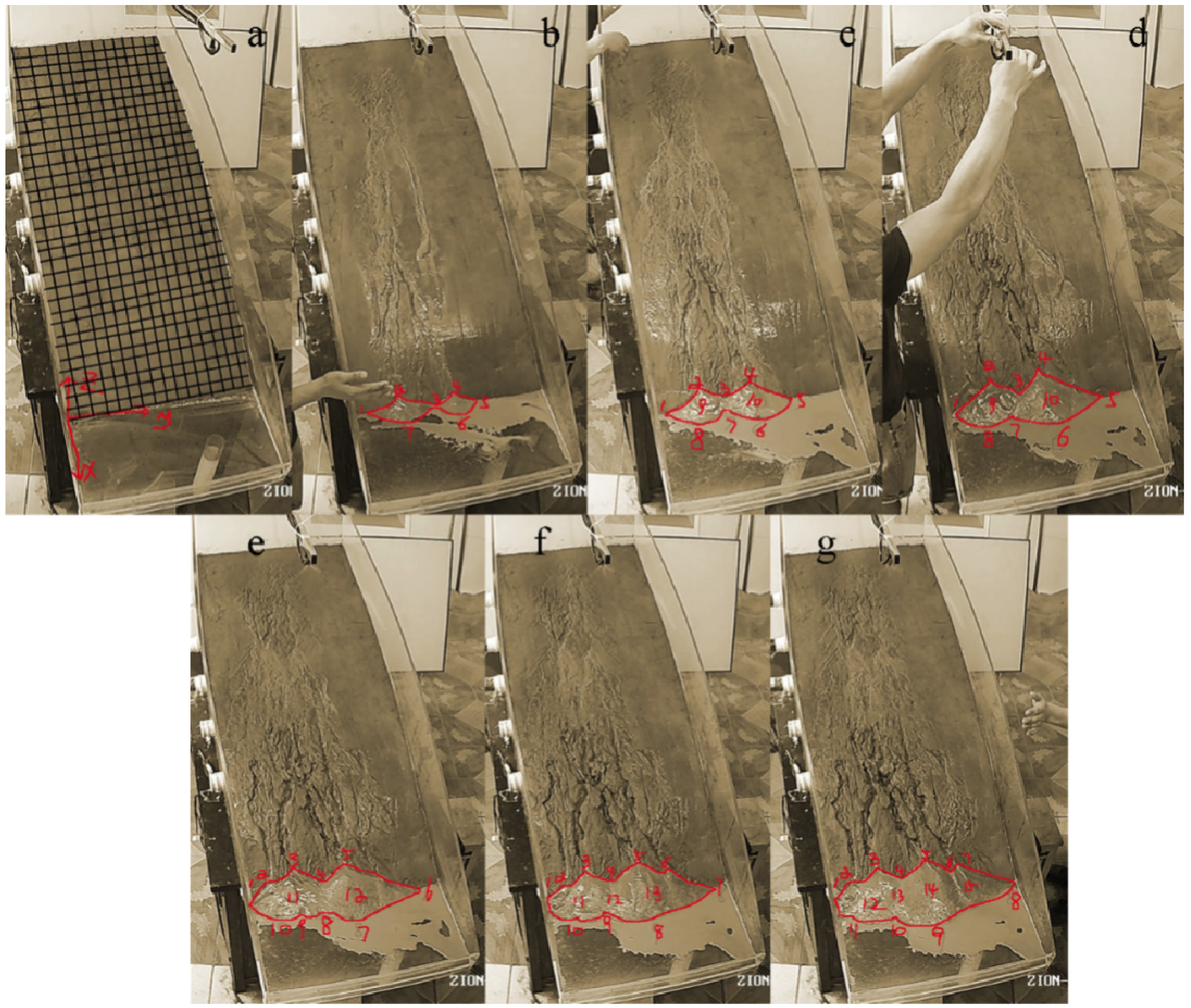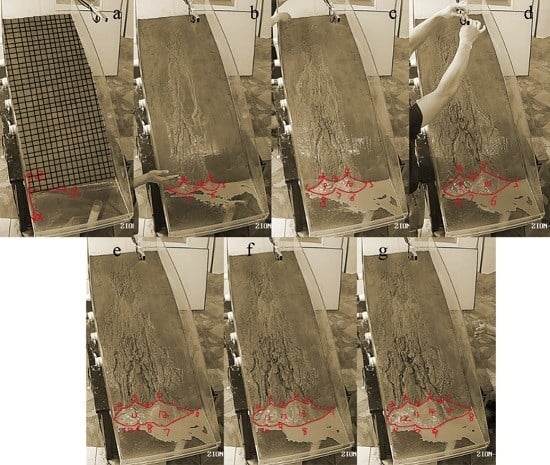A Physically—Based Geometry Model for Transport Distance Estimation of Rainfall-Eroded Soil Sediment
Abstract
:1. Introduction
2. Methods
2.1. Physical Modeling and Monitoring Devices


2.2. Calculations of Sediment Volume



2.3. Geometry Model for the Eroded Soil Maximum Transport Distance
2.3.1. Maximum Transport Distance

2.3.2. Geometry Model for Sediment Maximum Transport Distance

2.4. Model Fit and Validation
3. Results
3.1. Sediment Yield Volumes under Rainfall Events


| Label | Fitted Equation | SSE (m3) | R-Square | RMSE (m3) | p-Value |
|---|---|---|---|---|---|
| 1 | (ax + by) + c | 0.0001378 | 0.7936 | 0.0007281 | <0.01 |
| 2 | a(xy) + b | 0.0003277 | 0.9509 | 0.0003484 | <0.01 |
3.2. Geometry Model for the Eroded Soil Transport Distance

4. Discussion
4.1. Rainfall Producing Yield Soil Sediment

4.2. Geometry-Based Model for the Transport Distance



4.3. Limitations and Suggestions for Future Study
5. Conclusions
Acknowledgments
Author Contributions
Conflicts of Interest
Glossary
| I | rainfall intensity |
| r | rainfall intensity threshold of sediment movement |
| Sl | rainfall area |
| V | volume of eroded sediment in time t |
| t | rainfall time |
| a1 | fitting coefficient |
| a2 | fitting coefficient |
| R | cumulative rainfall |
| Rr | cumulative rainfall threshold of initial sediment |
lateral area | |
height of debris | |
maximum transport distance | |
length of sediment shadow minus the | |
angle of slope | |
angle of sediment | |
| E | percentage of erosion |
References
- Wischmeier, W.H.; Smith, D.D. Predicting rainfall erosion losses. In USDA Agricultural Handbook; U.S. Department of Agriculture: Washington, DC, USA, 1978. [Google Scholar]
- Renard, K.G.; Foster, G.R.; Weesies, G.A.; McCool, D.K.; Yoder, D.C. Predicting soil erosion by water: A guide to conservation planning with the Revised Universal Soil Loss Equation RUSLE. In Agriculture Handbook; U.S. Department of Agriculture: Washington, DC, USA, 1997. [Google Scholar]
- Flanagan, D.C.; Nearing, M.A. USDA Water Erosion Prediction Project: Hillslope Profile and Watershed Model Documentation; USDA-ARS National Soil Erosion Research Laboratory: West Lafayette, IN, USA, 1995.
- Morgan, R.P.C.; Quinton, J.N.; Smith, R.E.; Govers, G.; Poesen, J.W.A.; Auerswald, K.; Chisci, G.; Torri, D.; Styczen, M.E. The European Soil Erosion Model (EUROSEM): A dynamic approach for predicting sediment transport from fields and small catchments. Earth Surf. Process. Landf. 1998, 23, 527–544. [Google Scholar] [CrossRef]
- Smith, R.E.; Goodrich, D.C.; Quinton, J.N. Dynamic, distributed simulation of watershed erosion: The KINEROS2 and EUROSEM models. J. Soil Water Conserv. 1995, 50, 517–520. [Google Scholar]
- De Roo, A.P.J.; Wesseling, C.G.; Ritsema, C.J. LISEM: A single-event physically based hydrological and soil erosion model for drainage basins. I: Theory, input and output. Hydrol. Process. 1996, 10, 1107–1117. [Google Scholar] [CrossRef]
- Bennett, J.P. Concepts of mathematical modelling of sediment yield. Water Resour. Res. 1974, 10, 485–492. [Google Scholar] [CrossRef]
- Wainwright, J.; Parsons, A.J.; Abrahams, A.D. Field and computer simulation experiments on the formation of desert pavement. Earth Surf. Process. Landf. 1999, 24, 1025–1037. [Google Scholar] [CrossRef]
- Parsons, A.J.; Wainwright, J.; Powell, M.; Kaduk, J.D.; Brazier, R.E. A conceptual model for determining soil erosion by water. Earth Surf. Process. Landf. 2004, 29, 1293–1302. [Google Scholar] [CrossRef]
- Hassan, M.; Church, M.; Ashworth, P.J. Virtual rate and mean distance of travel of individual clasts in gravel-bed channels. Earth Surf. Process. Landf. 1992, 17, 617–627. [Google Scholar] [CrossRef]
- Schmidt, J. (Ed.) Soil Erosion: Application of Physically Based Models; Springer Science & Business Media: Berlin, Germany, 2013.
- Nie, W.; Huang, R.Q.; Zhang, Q.G.; Xian, W.; Xu, F.L.; Chen, L. Prediction of experimental rainfall-eroded soil area based on S-shaped growth curve model framework. Appl. Sci. 2015, 5, 157–173. [Google Scholar] [CrossRef]
- Rong, B.A.I. Stability analysis and control to Mingshan Landslide of Fengdu in the Three Gorges Reservoir Area. J. Lanzhou Railw. Inst. 2002. (In Chinese) [Google Scholar] [CrossRef]
- Fan, J.; Liu, F.; Guo, F.; Zhang, H. Soil erosion assessment and cause analysis in three gorges reservoir area based on remote sensing. J. Mt. Sci. 2011, 39, 306–311. (In Chinese) [Google Scholar]
- Fencík, R.; Vajsáblová, M. Parameters of interpolation methods of creation of digital model of landscape. In Proceedings of the 9th AGILE Conference on Geographic Information Science, Visegrád, Hungary, 20–22 April 2006.
- Draper, N.R.; Smith, H. Applied Regression Analysis, 3rd ed.; John Wiley: New York, NY, USA, 1998. [Google Scholar]
- Steel, R.G.D.; Torrie, J.H. Principles and Procedures of Statistics with Special Reference to the Biological Sciences; McGraw Hill: New York, NY, USA, 1960; pp. 187–287. [Google Scholar]
- Hyndman, R.J.; Koehler, A.B. Another look at measures of forecast accuracy. Int. J. Forecast. 2006. [Google Scholar] [CrossRef]
- Römkens, M.J.; Helming, K.; Prasad, S.N. Soil erosion under different rainfall intensities, surface roughness, and soil water regimes. Catena 2002, 46, 103–123. [Google Scholar] [CrossRef]
- Van Rompaey, A.; Bazzoffi, P.; Jones, R.J.; Montanarella, L. Modeling sediment yields in Italian catchments. Geomorphology 2005, 65, 157–169. [Google Scholar] [CrossRef] [Green Version]
- Bathurst, J.C.; Wicks, J.M.; O’Connell, P.E. The SHE/SHESED basin scale water flow and sediment transport modelling system. In Computer Models of Watershed Hydrology; Singh, V.P., Ed.; Water Resource Publication: Highlands Ranch, CO, USA, 1995; pp. 563–594. [Google Scholar]
- Upton, J.G.G.; Fingleton, B. Spatial Data Analysis by Example. Volume 1: Point Pattern and Quantitative Data; Wiley: Chichester, UK, 1985. [Google Scholar]
© 2016 by the authors; licensee MDPI, Basel, Switzerland. This article is an open access article distributed under the terms and conditions of the Creative Commons by Attribution (CC-BY) license (http://creativecommons.org/licenses/by/4.0/).
Share and Cite
Zhang, Q.-G.; Huang, R.-Q.; Liu, Y.-X.; Su, X.-P.; Li, G.-Q.; Nie, W. A Physically—Based Geometry Model for Transport Distance Estimation of Rainfall-Eroded Soil Sediment. Appl. Sci. 2016, 6, 34. https://doi.org/10.3390/app6020034
Zhang Q-G, Huang R-Q, Liu Y-X, Su X-P, Li G-Q, Nie W. A Physically—Based Geometry Model for Transport Distance Estimation of Rainfall-Eroded Soil Sediment. Applied Sciences. 2016; 6(2):34. https://doi.org/10.3390/app6020034
Chicago/Turabian StyleZhang, Qian-Gui, Run-Qiu Huang, Yi-Xin Liu, Xiao-Peng Su, Guo-Qiang Li, and Wen Nie. 2016. "A Physically—Based Geometry Model for Transport Distance Estimation of Rainfall-Eroded Soil Sediment" Applied Sciences 6, no. 2: 34. https://doi.org/10.3390/app6020034
APA StyleZhang, Q.-G., Huang, R.-Q., Liu, Y.-X., Su, X.-P., Li, G.-Q., & Nie, W. (2016). A Physically—Based Geometry Model for Transport Distance Estimation of Rainfall-Eroded Soil Sediment. Applied Sciences, 6(2), 34. https://doi.org/10.3390/app6020034








